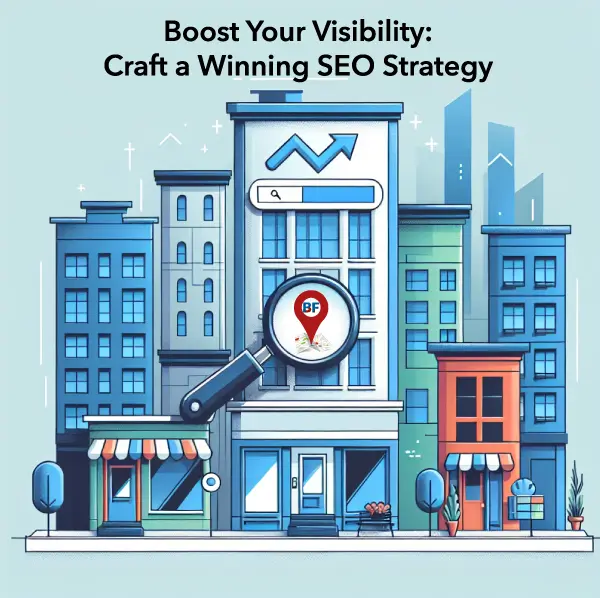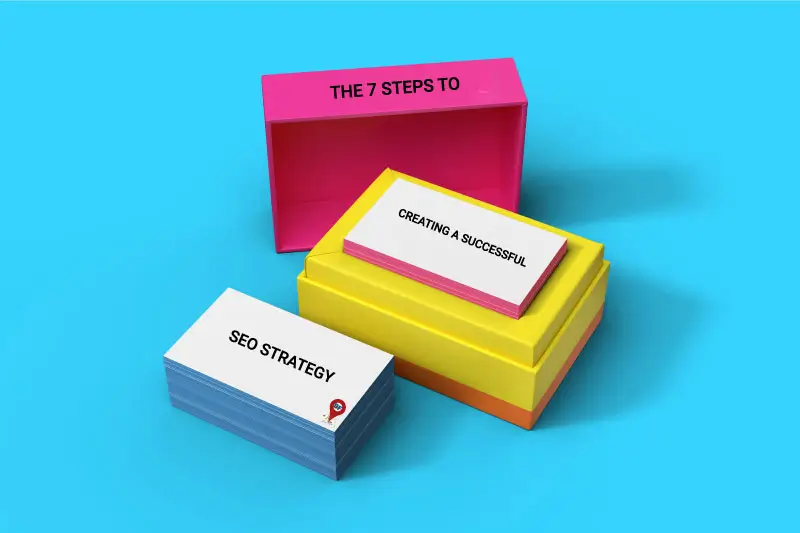How To Create A Successful SEO Strategy for Your Business?
SEO is much more than just creating content for the keywords your users/readers are searching for. Surprised?
You’re not the only one who thinks that an SEO strategy should be focused on keywords. However, that’s no longer enough to achieve your marketing objectives.
Many business owners understand the basics of SEO and its importance. However, they often need to pay more attention to the content they produce and should first serve the needs of their audience and then their own.
Creating a strong, solid, and successful SEO Strategy would be best.
Google wants high-quality, relevant content that provides value to users. If you’re wondering why your SEO strategy isn’t working, you might be creating content mainly focused on keywords.
In this “How To Create A Successful SEO Strategy for Your Business” article, I’ll walk you through a time-tested and proven process of creating an effective SEO strategy for your business.
This strategy helps you rank and meet your audience’s needs.
We'll cover:
What is an SEO Strategy?
An SEO strategy is your one crucial plan for improving your website’s visibility in search engine results.
It’s like a roadmap guiding your efforts to attract and increase organic traffic and boost your online presence. It is your secret sauce for serving your website to hungry searchers.
Let’s break it down with a fun analogy. Imagine you’re running a pizza shop (including your competitors) in a busy section within your city.
Your SEO strategy for your pizza shop would be like your plan to:
- Make your pizza store visible (optimize your website)
- Create the best pizza recipe (develop high-quality content)
- Get people talking about your delicious pizza (build backlinks)
- Understand what toppings people like (competitive analysis + keyword research)
- Adjust your recipe based on customer feedback (monitor and refine)
Like a successful local business, a good SEO strategy requires planning, execution, and continuous improvement.
Why Your Business Needs a Reliable SEO Strategy

Picture this:
You’ve invested thousands to open your business and create a website, but customers can’t find your products or services online. Frustrating, right?
That’s where search engine optimization -SEO comes in.
By implementing a solid SEO strategy, you can:
- Increase organic traffic to your website
- Boost brand awareness
- Attract more qualified leads
- Improve your return on investment (ROI)
- Stay ahead of your competitors
- Build credibility and trust with your audience
In fact, according to a study by BrightEdge, organic search drives 53% of all website traffic. That’s a lot of potential customers you could be missing out on!
But here’s the kicker…
Search engine optimization is about more than just getting more traffic.
A successful search engine optimization strategy is about getting the right traffic—people interested in what you offer.
It’s like inviting the right guests to your party—the ones who’ll enjoy themselves and maybe even bring their friends next time.
You might wonder, “Can I handle this SEO stuff alone?”
Well, it depends on your situation. You can do SEO with the time and expertise in search engine optimization.
It’s like learning to cook gourmet meals—challenging but rewarding if you’re up for it.
But let’s face it—running a business is already a full-time job. If you prefer to focus on what you do best—managing your company—there’s another option.
Reaching out to a marketing agency that offers SEO services within your budget can be smart.
Investing in search engine optimization services like hiring a professional chef for your restaurant—they bring expertise and allow you to concentrate on other aspects of your business.
Both approaches have their merits. The key is choosing the path that best fits your resources, goals, and personal preferences.
7 Steps to Create a Successful SEO Strategy

Ready to roll up your sleeves and get started? Here’s your step-by-step guide to crafting an SEO strategy that works:
1. Know Your Audience
Before you dive into keyword research, take a moment to understand who you’re trying to reach.
Create buyer personas to understand your target audience’s needs, preferences, and online behavior.
Ask yourself:
- What problems are they trying to solve?
- What kind of language do they use?
- Where do they hang out online?
- What devices do they use to search?
Understanding your audience will help you create content that resonates with them and addresses their needs. It’s like being a mind reader but for your customers’ online habits!
Pro tip: Don’t just guess. Use tools like Google Analytics to gather real data about your website visitors. You might be surprised by what you find!
Here’s a quick exercise to help you get started:
- List your top 3 customer types
- For each type, write down:
- Their age range
- Job title or industry
- Main challenges they face
- How your product/service helps them
- Look at your website analytics to see if your assumptions match reality
Remember, the better you know your audience, the more effectively you can tailor your SEO strategy to meet their needs.
2. Conduct Thorough Keyword Research
Now that you know your audience, it’s time to discover what they’re searching for.
Use tools like Google Keyword Planner, SEMrush, or Ahrefs to do keyword research and discover relevant keyphrases and search terms related to your business.
Pro tip: Don’t just focus on high-volume keywords. Long-tail keywords often have less competition and can drive more targeted traffic.
When conducting keyword research:
- Look for a mix of short-tail and long-tail keywords
- Consider search intent (informational, navigational, transactional)
- Check out your competitors’ keywords
- Use question-based keywords to target featured snippets
Remember, keyword research isn’t a one-time task. Keep updating your list as trends and search behaviors change. It’s like keeping your finger on the pulse of your industry’s online conversations.
Here’s a step-by-step process for effective keyword research:
- Start with a seed list of broad topics related to your business
- Use keyword research tools to expand this list
- Analyze the search volume and competition for each keyword
- Group keywords by topic and search intent
- Prioritize keywords based on their potential value to your business
Remember to look for seasonal trends in your keyword research. Tools like Google Trends can help you identify when certain keywords are more popular throughout the year.
3. Analyze Your Competition
A competitive analysis campaign will examine your competition and report on their activities.
These include ranking for which keywords, creating what type of content, and identifying their strengths and weaknesses. Use this information to identify gaps and opportunities in your SEO strategy.
Tools like SEMrush and Ahrefs can help you:
- Identify your top organic competitors
- Analyze their backlink profiles
- Discover their top-performing content
- Find keywords they’re ranking for that you’re not
Use this information to inform your strategy and find ways to outperform your competitors. It’s like being a spy in the SEO world, but legal and ethical!
Here’s a competitive analysis checklist:
- Identify your top 5 competitors in search results
- Analyze their website structure and content organization
- Look at their on-page SEO elements (title tags, meta descriptions, headers)
- Check their content quality and depth
- Examine their backlink profile
- Note any featured snippets or SERP features they’re capturing
Remember, the goal isn’t to copy your competitors but to learn from their successes and failures. Use this information to create a unique SEO strategy that sets you apart.
4. Optimize Your On-Page SEO
Make sure your website is speaking the same language as search engines.
This includes:
- Using relevant keywords in your page titles, headers, and content
- Creating unique and informative meta-descriptions
- Optimizing your images with alt text
- Ensuring your website has a logical structure with internal linking
- Improving your site’s loading speed
- Making your site mobile-friendly
Remember, on-page SEO isn’t just about keywords. It’s about creating a great user experience that keeps visitors on your site and encourages them to explore further.
Think of it as rolling out the red carpet for your website visitors.
Here’s a quick on-page SEO checklist (used by BuzFind’s SEO specialists):
- Optimize your title tags (keep them under 60 characters)
- Write compelling meta descriptions (aim for 150-160 characters)3. Use header tags (H1, H2, H3) to structure your content
- Include your target keyword in the first 100 words of your content
- Optimize images (compress them and use descriptive file names and alt text)
- Use internal links to help users and search engines navigate your site
- Ensure your content is easy to read (use short paragraphs, bullet points, and subheadings)
Remember technical SEO elements like site speed and mobile-friendliness. Use tools like Google’s PageSpeed Insights to identify and fix any issues.
5. Create High-Quality, Valuable Content
Content is king in the world of SEO. Develop a content strategy that naturally addresses your audience’s needs and incorporates your target keywords. Remember, quality trumps quantity every time.
When creating content:
- Focus on solving your audience’s problems
- Use a variety of content formats (blog posts, videos, infographics, podcasts)
- Update and refresh your existing content regularly
- Create in-depth, comprehensive pieces (aim for at least 1,500 words)
- Include relevant internal and external links
Remember to optimize your content for featured snippets by including clear, concise answers to common questions. It’s like serving up bite-sized pieces of information that Google loves to showcase.
Here’s a content creation process that works (time-tested by our content creators):
- Choose a topic based on your keyword research
- Research thoroughly (look at top-ranking content for inspiration)
- Create an outline
- Write your first draft
- Edit and optimize for SEO
- Add visuals (images, videos, infographics)
- Publish and promote
Feeling overwhelmed by all this content creation? We get it.
Running a business is tough, and writing is only some people’s cup of tea. That’s where our content writing services come in handy.
We’re like your personal team of wordsmiths, ready to create engaging content that speaks to your audience and pleases search engines.
Whether you’re too busy or need more confidence in your writing skills, we’ve got your back. Let us handle the words while you focus on what you do best – growing your awesome business!
6. Build High-Quality Backlinks
Backlinks are like votes of confidence for your website. Focus on earning links from reputable, relevant websites in your industry.
You can do this by:
- Creating shareable content
- Guest posting on industry blogs
- Participating in industry events or webinars
- Reaching out to influencers and thought leaders
- Leveraging broken link-building strategies
- Creating and promoting infographics
Remember, quality is far more important than quantity regarding backlinks.
A few high-quality links from authoritative sites can do more for your SEO than hundreds of low-quality links. It’s like having a few powerful friends vouching for you rather than a bunch of acquaintances.
Here’s a step-by-step guide to building quality backlinks:
- Create linkable assets (comprehensive guides, original research, infographics)
- Identify link prospects (use tools like Ahrefs to find sites linking to your competitors)
- Reach out with personalized emails (explain how your content adds value)
- Follow up (but don’t be pushy)
- Track your progress and adjust your strategy as needed
Remember internal linking! A strong internal link structure helps distribute link equity throughout your site, making it easier for search engines to crawl and understand your content.
7. Monitor and Adjust Your SEO Strategy
SEO isn’t a set-it-and-forget-it task. Regularly monitor your website’s performance using tools like Google Analytics and Google Search Console. Use these insights to refine and improve your SEO strategy over time.
Key metrics to track include:
- Organic traffic
- Keyword rankings
- Bounce rate
- Time on site
- Conversion rate
- Backlink profile
Feel free to experiment and try new tactics. SEO is an ever-evolving field; what works today might not work tomorrow. It’s like being a scientist in your SEO lab – always testing, learning, and improving.
Here’s a monthly 7 steps SEO check-up routine:
- Review your organic traffic trends
- Check your keyword rankings
- Analyze your top-performing pages
- Look for any technical issues (crawl errors, broken links)
- Monitor your backlink profile
- Review your content performance
- Set goals for the next month
Remember to monitor industry news and algorithm updates. Staying informed helps you adapt your strategy quickly when changes occur.
Warning: Beware of Private Blog Networks (PBNs) – A Risky Shortcut in SEO
While monitoring your backlink profile, being aware of potentially harmful link-building tactics is crucial.
Private Blog Networks (PBNs) are groups of websites created solely to manipulate search engine rankings by providing backlinks to a target site.
Although they might boost SEO quickly, PBNs are a black-hat technique that can result in severe search engine penalties.
PBNs violate Google’s Webmaster Guidelines and can lead to your site being de-indexed or significantly dropping in rankings.
Instead of risking your website’s reputation and visibility, focus on earning high-quality backlinks through legitimate means.
Our experienced SEO strategists at BuzFind emphasize that relevant, high-quality content naturally attracts backlinks. While building relationships with authoritative websites in your niche can be challenging, it’s a sustainable approach that yields long-term results.
Remember, in SEO, there are no shortcuts to lasting success. Stick to white-hat techniques to build a sustainable and penalty-proof SEO strategy.
If you need help developing a robust, ethical backlink strategy or with any aspect of your SEO, feel free to call us at 484-662-3084, email us, or book a free SEO strategy consultation. Our team of experts is ready to guide you towards sustainable SEO success.
Common SEO Strategy Pitfalls to Avoid

As you implement your SEO strategy, watch out for these common mistakes:
- Keyword stuffing: Using keywords can help your rankings and turn off readers. It’s like overseasoning your food – a little goes a long way!
- Ignoring mobile optimization: With mobile searches rising, ensure your website is mobile-friendly. Don’t leave smartphone users out in the cold!
- Neglecting local SEO: If you have a physical location, optimize for local searches. It’s like putting your business on the map—literally!
- Focusing solely on rankings: While rankings are important, consider user experience and conversion rates. What’s the point of being #1 if no one sticks around?
- Buying links: Buying links can lead to penalties from search engines. Focus on earning links naturally. It’s like trying to buy friends—it never works out in the long run.
- Ignoring technical SEO: Issues like slow loading times and broken links can hurt your rankings. Don’t let technical glitches be your SEO kryptonite!
- Not optimizing for voice search: With the rise of smart speakers, optimizing for voice search is becoming increasingly important. Get ready to answer, “Hey Google!”
Frequently Asked Questions: How To Create A Successful SEO Strategy for Your Business
How long does it take to see results from an SEO strategy?
SEO is a long-term game. While you might see some improvements within a few months, significant results typically take 6-12 months.
How often should I update my SEO strategy?
Your SEO strategy should be a living document. Review and adjust it quarterly, but be prepared to make changes more frequently if you notice significant shifts in your industry or search trends.
Is it better to focus on on-page SEO or link building?
Both are crucial components of a successful SEO strategy. Start with on-page SEO to optimize your website, then focus on link-building to boost your authority.
How can I measure the success of my SEO strategy?
Key performance indicators (KPIs) for SEO include organic traffic growth, keyword rankings, conversion rates, and backlink quality. Tools like Google Analytics and Google Search Console can be used to track these metrics over time.
Should I hire an SEO agency or do it in-house?
This depends on your resources, time, expertise, and goals. If you have the time and willingness to learn, you can handle basic SEO in-house. However, working with an experienced SEO agency can be beneficial for more complex strategies or faster results.
How does voice search impact SEO strategy?
Voice search is changing the way people interact with search engines. To optimize for voice search:
1. Focus on long-tail, conversational keywords
2. Create content that answers specific questions
3. Optimize for local searches (many voice searches are location-based)
4. Improve your website’s loading speed (voice search favors fast-loading sites)
Remember, voice search queries are often in the form of questions, so structuring your content to answer these questions can help improve your visibility in voice search results.
How important is site speed for SEO?
Site speed is crucial for SEO. Google has explicitly stated that site speed is a ranking factor and is even more important for mobile searches. A slow-loading site can increase bounce rates and decrease user satisfaction, negatively impacting your rankings.
Wrapping up
Creating a successful SEO strategy takes time and effort, but the rewards are worth it.
By following these steps and staying up-to-date with SEO best practices, you’ll be well on your way to improving your website’s visibility and attracting more customers.
Remember, SEO is a marathon, not a sprint. Stay patient, keep learning, and don’t hesitate to ask for help when needed.
With persistence and the right approach, you’ll soon see your website climbing those search engine rankings!
If you need help creating a successful SEO strategy for your business, we can help! Contact us today.
Good Reads: Moz’s Beginner’s Guide to SEO.

